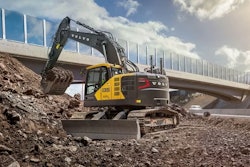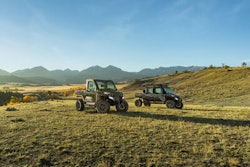Getting feedback from experienced grader operators and owners was a key – and from all indications, prized – part of Volvo’s design process on its G900 Series motor graders. And the engineers made copious notes as this group had no shortage of opinions: While the operators loved the tighter turning radius and what they termed “perfect hydraulics” on the prototype machines, they had one repeated request: please relocate the often used powertrain switches from the side panel to the center pedestal. Volvo complied, although it was no easy task, requiring a significant rewiring of the cab.
But Volvo knows keeping grader operators – long considered at the top of the skill chain – happy and productive is a paramount concern in grader design.
“Operators measure grader productivity by how much material it can cut and push or, in other words, how much it can translate its engine power into traction while maintaining control,” says Brian Lowe, product and communications manager, Volvo Motor Graders. And so the company strengthened this productivity on the G900 Series by using wide-stance blade lift cylinders coupled with a low-angle side-shift cylinder, giving the machines a stable grading platform. The structural design concentrates on placing its power and weight to maximize blade down force and drawbar pull rates.
Proportional Demand Flow load-sensing hydraulics, combined with a twin-gear, direct-drive circle turn system, create a precise, responsive tool, holding and turning the moldboard smoothly while moving under full load.
Smoothness on the go
All seven models have three standard power ranges, depending upon the transmission gear selected. These power ranges work to enhance overall fuel efficiency by matching engine power to the application.
The standard eight forward/four reverse HTE840 transmission is offered with an optional automatic transmission that allows operators to choose between three operating modes: manual, autoshift (which lets the operator select the target gear, allowing the transmission to automatically shift through turns and grades as needed) and travel.
Volvo also offers the optional HTE1160 11 forward/six reverse transmission, which it claims as an industry first. “More than 70 percent of our orders to date have chosen this option,” Lowe says. “It allows you to go slower for fine grading, be more precise in the middle gears and travel more efficiently in the high gears.” Autoshift is standard on the HTE1160.
The two all-wheel-drive machines, the G946 and G976, offer three drive systems in one: a four-wheel tandem drive, a six-wheel drive for both traction and high-speed snow clearing, and Volvo’s front-wheel Creep Mode for precise fine grade control. In the Creep Mode, you grade using only the hydrostatic front-wheel drive while the rear tandem wheels roll freely behind, minimizing scuffing and rework. (For a quick look at the essential specs on all seven models see the chart on this page.)
The shift joystick operates in an “I” formation. Push the joystick forward from its neutral middle position to the top part of the “I” and it moves into forward; each subsequent push and release to the right advances the transmission a gear. Downshift by pushing and releasing to the left.
But here’s the slick part: The standard shuttle shift feature allows shuttling between selected forward and reverse gears in a single smooth motion. If you want to change from forward to reverse, simply pull the lever in a straight line to the bottom part of the “I”. No clutches, no sudden stops, no stalled engines. Similarly the operator can select forward by pushing the lever straight ahead. The reverse or bottom part of the “I” works the same way as the top portion. Go faster by pushing and releasing the stick to the right and slow down by moving it to the left. Both transmissions are direct drive so there’s no surging or fuel waste through torque converter slippage.
A true work environment
G900 Series designers took several cues from Volvo’s wheel loader cab, including interior lights and steps and handholds that illuminate as soon as the cab door is open. Visibility received several upgrades, including something as simple as the wiper blade pattern, which now wipes to the corner, exactly where an operator looks at a blade. In addition, all six cab posts are now integrated into the ROPS, which let Volvo shrink the size of the posts, allowing for more glass.
Six interior and exterior mirrors give the operator a command-post view around the machine. Two large filters maintain a constant flow of clean air from 10 outlets. All essential operator controls are mounted on a slide and tilt adjustable center pedestal.
All service points, including fuel fill, are at ground level. The radiator fan only runs on demand, reducing the amount of time it’s running at its full load and thus reducing fuel consumption.
Engine
Depending on size, the graders have one of two power platforms of V-ACT (Volvo Advanced Combustion Technology) engines. The D7 platform, which ranges from 155 to 235 horsepower, powers the G930, G940, G946 and G960 models. The D9, ranging from 210 to 265 horsepower, is on the G970, G976 and G990.
These electronically controlled units feature advanced high pressure fuel injectors, switchable internal exhaust gas recirculation, improved piston geometry and high-efficiency fixed geometry turbochargers. “These are not cooled EGR engines, but rather have a switchable exhaust rocker device that allows a controlled amount of exhaust gas to be fed back into the cylinder during the inlet stroke,” says Carrie-Ann Baker, director, key accounts. “This in turn deoxidizes combustion air so the engine produces less nitrogen oxide without cooling the exhaust gas, providing a less complicated “in cylinder” emissions solution while maintaining performance, fuel economy and reliability.” And it’s not dependent on the availability of ultra-low-sulfur fuel to work well, although this fuel can be used without adverse affects.
Each model has three different power levels, so the horsepower is matched not only to the weight of the machine, but the application at hand.









